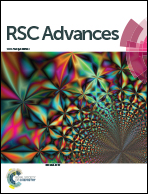Organic–inorganic hybrid CH3NH3PbI3 perovskite materials as channels in thin-film field-effect transistors
Abstract
Organic–inorganic hybrid perovskite materials promise both the superior carrier mobility of inorganic semiconductors and the processability of organic materials, which make organic–inorganic hybrid perovskite materials good substitutes in all the applications put forth for organic materials and extend their application to higher speed devices than is presently possible with either a-Si or organic semiconductors. Recent reports have shown high carrier mobility and long electron–hole diffusion lengths of organic–inorganic hybrid perovskite materials. We have demonstrated a thin-film field-effect transistor with an organic–inorganic hybrid CH3NH3PbI3 material as the semiconducting channel based on these advantages via a low-temperature vapor-assisted solution process. The obvious electrical field effect is obtained in organic–inorganic hybrid CH3NH3PbI3 perovskite TFTs with a field-effect mobility of 396.2 cm2 V−1 s−1, current modulation greater than 104, sub-threshold current of 0.4035 V per decade and threshold voltage of −3.501 V.


 Please wait while we load your content...
Please wait while we load your content...